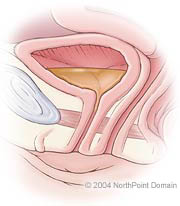Cystoscopy

Basic Facts
- Cystoscopy, the use of a viewing instrument (often called an endoscope or cystoscope) to examine the bladder and urethra, is used to diagnose and treat conditions of the urinary tract.
- Cystoscopes contain a lens and light to view internal tissues of the body.
- Cystoscopes are of two types: rigid and flexible. Increasingly, diagnostic cystoscopy is performed with a flexible scope, particularly in men. Rigid cystoscopy is still often used, especially when biopsies are needed or stents (tiny silicone or synthetic tubes) need to be inserted.
- When used diagnostically, a cystoscopy usually takes less than 15 minutes and may only require the use of anesthetic gel to prevent discomfort.
Cystoscopy is a test that allows the urologist to directly view the inside of the male and female bladder and urethra to diagnose diseases of the urinary tract and, in men, the prostate. The flexible cystoscope is made of thin, flexible glass fibers, and the rigid cystoscope is a solid, straight device. Both cystoscopes are inserted into the urethra.Cystoscopy is commonly recommended for patients who:
- Experience frequent urinary tract infections;
- Have blood in their urine;
- Experience loss of bladder control; or
- Have an overactive bladder, urinary blockage, or painful urination.
RISK FACTORS
Rarely, the insertion of the cystoscope into the urethra can introduce bacteria into the urinary tract.
PRE-TEST GUIDELINES
The night before a cystoscopy, patients should drink lots of fluids (mainly water) to increase urine flow.
If general anesthesia is required, patients should not eat or drink anything for at least 6 hours (sometimes up to 12 hours), usually after midnight the evening before the cystoscopy.
Patients may be asked take antibiotics the day before cystoscopy and may be asked to continue them 1 to 3 days to prevent infection.
Patients should inform their physician if they are taking blood thinners.
WHAT TO EXPECT
As the procedure begins, the patient lies on his or her back with the knees raised and apart, often in stirrups. The physician inserts the cystoscope through the urethra to the bladder. Once the cystoscope reaches the bladder, the physician fills the bladder with sterile water or saline solution through a channel in the scope. Biopsies or urine samples taken during the test will be sent to a lab. The entire cystoscopy procedure will last from 15 to 45 minutes.
POST-TEST GUIDELINES
Patients are encouraged to drink lots of fluids (mainly water) following cystoscopy.
POSSIBLE COMPLICATIONS
While rare, a cystoscopy may cause one or more of the following complications:
- Tearing of the urethra or bladder;
- Epididymitis;
- Bleeding from a biopsy;
- Urinary retention; and
- Fever, flushing, or chills.
The patient should immediately report any of these complications to his or her physician.
Copyright © 2017 NorthPoint Domain, Inc. All rights reserved.
This material cannot be reproduced in digital or printed form without the express consent of NorthPoint Domain, Inc. Unauthorized copying or distribution of NorthPoint Domain’s Content is an infringement of the copyright holder’s rig

